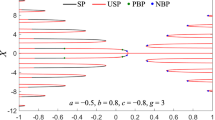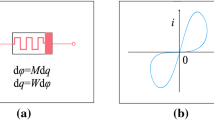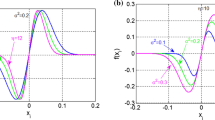Abstract
External stimulus has an impact on the functional behavior of the biological nervous system, and appropriate stimulus helps the organism to maintain neural function. Inspired by this, the effects of different external stimuli on the dynamical behaviors of neuron model are studied in this paper. Firstly, a fractional-order (FO) memristor-coupled tabu learning two-neuron model whose equilibrium points are symmetric about the origin and unstable is constructed. The dynamical behaviors of this neuron model under different stimuli are further discussed, which are no external stimulus, external forced current stimulus, and electromagnetic radiation (EMR), respectively. The neuron model without external stimulus has periodic attractors and transient chaos, but applying external stimulus to one of the neurons can produce abundant two-scroll chaotic attractors and multistability; especially, when the neuron model is stimulated by EMR, it can generate hyperchaotic attractors that have not been observed in the tabu learning neuron model before. Besides, the transient transition behaviors of the model under different stimuli are also studied. Then, a pseudo-random number generator is designed and its random performance is tested with NIST suite. Finally, it is applied to voice encryption, and the result shows that it has good encryption effect. Therefore, it can be said that the FO memristor-coupled tabu learning two-neuron model has superior randomness and is suitable for chaotic-based engineering applications.


































Similar content being viewed by others
Data availability
Data will be made available on reasonable request.
References
Lin, H.R., Wang, C.H., Chen, C.J., et al.: Neural Bursting and Synchronization Emulated by Neural Networks and Circuits. IEEE Trans. Circ. Syst. I Reg. Pap. 68(8), 3397–3410 (2021). https://doi.org/10.1109/TCSI.2021.3081150
Liu, Y., Huang, X., Li, Y.X., Shen, H.: Multistability of Hopfield neural networks with a designed discontinuous sawtooth-type activation function. Neurocomputing 455, 189–201 (2021). https://doi.org/10.1016/j.neucom.2021.05.045
Korn, H., Faure, P.: Is there chaos in the brain? II. Experimental evidence and related models. Compt. Rendus Biol. 326(9), 787–840 (2003). https://doi.org/10.1016/j.crvi.2003.09.011
Li, Z.J., Zhou, H.Y., Wang, M.J., Ma, M.L.: Coexisting firing patterns and phase synchronization in locally active memristor coupled neurons with HR and FN models. Nonlinear Dyn. 104(2), 1455–1473 (2021). https://doi.org/10.1007/s11071-021-06315-4
Li, C.G., Chen, G.R., Liao, X.F., et al.: Hopf bifurcation and chaos in Tabu learning neuron models. Int. J. Bifurc. Chaos 15(8), 2633–2642 (2005). https://doi.org/10.1142/S0218127405013575
Doubla, I.S., Njitacke, Z.T., Ekonde, S., et al.: Multistability and circuit implementation of tabu learning two-neuron model: application to secure biomedical images in IoMT. Neural Comput. Appl. 33(21), 14945–14973 (2021). https://doi.org/10.1007/s00521-021-06130-3
Kawahara, M., Kato-Negishi, M., Tanaka, K.: Cross talk between neurometals and amyloidogenic proteins at the synapse and the pathogenesis of neurodegenerative diseases. Metallomics 9(6), 619–633 (2017). https://doi.org/10.1039/c7mt00046d
Ding, D.W., Jiang, L., Hu, Y.B., et al.: Hidden dynamical behaviors, sliding mode control and circuit implementation of fractional-order memristive Hindmarsh−Rose neuron model. Eur. Phys. J. Plus 136(5), 521 (2021). https://doi.org/10.1140/epjp/s13360-021-01107-6
Hu, X.Y., Liu, C.X.: Bursting and synchronization of coupled neurons under electromagnetic radiation. Complexity 2019, 4835379 (2019). https://doi.org/10.1155/2019/4835379
Zhao, J.Y., Wang, Q.Y.: The dynamical role of electromagnetic induction in epileptic seizures: a double-edged sword. Nonlinear Dyn. 106(1), 975–988 (2021). https://doi.org/10.1007/s11071-021-06855-9
Lu, L.L., Jia, Y., Kirunda, J.B., et al.: Effects of noise and synaptic weight on propagation of subthreshold excitatory postsynaptic current signal in a feed-forward neural network. Nonlinear Dyn. 95(2), 1673–1686 (2019). https://doi.org/10.1007/s11071-018-4652-9
Wang, H.T., Chen, Y.: Spatiotemporal activities of neural network exposed to external electric fields. Nonlinear Dyn. 85(2), 881–891 (2016). https://doi.org/10.1007/s11071-016-2730-4
Li, J.J., Liu, S.B., Liu, W.M., et al.: Suppression of firing activities in neuron and neurons of network induced by electromagnetic radiation. Nonlinear Dyn. 83(1), 801–810 (2016). https://doi.org/10.1007/s11071-015-2368-7
Lin, H.R., Wang, C.H.: Influences of electromagnetic radiation distribution on chaotic dynamics of a neural network. Appl. Math. Comput. 369, 124840 (2020). https://doi.org/10.1016/j.amc.2019.124840
Ma, J., Zhang, G., Hayat, T., Ren, G.D.: Model electrical activity of neuron under electric field. Nonlinear Dyn. 95(2), 1585–1598 (2019). https://doi.org/10.1007/s11071-018-4646-7
Ge, M.Y., Lu, L.L., Xu, Y., et al.: Effects of electromagnetic induction on signal propagation and synchronization in multilayer Hindmarsh-Rose neural networks. Eur. Phys. J. Spec. Top 228(11), 2455–2464 (2019). https://doi.org/10.1140/epjst/e2019-900006-2
Li, H.M., Lu, Y.C., Li, C.L.: Dynamics in stimulation-based tabu learning neuron model. AE U-Int. J. Electron. Commun 142, 153983 (2021). https://doi.org/10.1016/j.aeue.2021.153983
Lin, H.R., Wang, C.H., Deng, Q.L., et al.: Review on chaotic dynamics of memristive neuron and neural network. Nonlinear Dyn. 106(1), 959–973 (2021). https://doi.org/10.1007/s11071-021-06853-x
Lv, M., Ma, J.: Multiple modes of electrical activities in a new neuron model under electromagnetic radiation. Neurocomputing 205, 375–381 (2016). https://doi.org/10.1016/j.neucom.2016.05.004
Lin, H.R., Wang, C.H., Li, C., et al.: Hyperchaotic memristive ring neural network and application in medical image encryption. Nonlinear Dyn. (2022). https://doi.org/10.1007/s11071-022-07630-0
Liao, M.L., Wang, C.H., Sun, Y.C., et al.: Memristor-based affective associative memory neural network circuit with emotional gradual processes. Neural. Comput. Appl. 34(16), 13667–13682 (2022). https://doi.org/10.1007/s00521-022-07170-z
Jia, J., Huang, X., Li, Y.X., et al.: Global stabilization of fractional-order memristor-based neural networks with time delay. IEEE Trans. Neural Netw. Learn. Syst. 31(3), 997–1009 (2020). https://doi.org/10.1109/TNNLS.2019.2915353
Yan, Z.L., Huang, X., Cao, J.D.: Variable-sampling-period dependent global stabilization of delayed memristive neural networks based on refined switching event-triggered control. Sci. China Inf. Sci. 63(11), 159–174 (2020). https://doi.org/10.1007/s11432-019-2664-7
Lai, Q., Wan, Z.Q., Zhang, H., Chen, G.R.: Design and analysis of multiscroll memristive hopfield neural network with adjustable memductance and application to image encryption. IEEE Trans. Neural Netw. Learn. Syst. (2022). https://doi.org/10.1109/TNNLS.2022.3146570
Hou, L.P., Bao, H., Xu, Q., Chen, M., Bao, B.C.: Coexisting infinitely many nonchaotic attractors in a memristive weight-based tabu learning neuron. Int. J. Bifur. Chaos 31(12), 2150189 (2021). https://doi.org/10.1142/S0218127421501893
Ren, G.D., Xu, Y., Wang, C.N.: Synchronization behavior of coupled neuron circuits composed of memristors. Nonlinear Dyn. 88(2), 893–901 (2017). https://doi.org/10.1007/s11071-016-3283-2
Bao, B.C., Yang, Q.F., Zhu, D., Zhang, Y.Z., et al.: Initial-induced coexisting and synchronous firing activities in memristor synapse-coupled Morris-Lecar bi-neuron network. Nonlinear Dyn. 99(3), 2339–2354 (2020). https://doi.org/10.1007/s11071-019-05395-7
Lin, H., Wang, C., Hong, Q., Sun, Y.: A multi-stable memristor and its application in a neural network. IEEE Trans. Circ. Syst. II Express Br. 67(12), 3472–3476 (2020). https://doi.org/10.1109/TCSII.2020.3000492
Huang, L.L., Liu, S., Xiang, J.H., et al.: Design and multistability analysis of memristor-based jerk hyperchaos system with controllable offset. Eur. Phys. J. Spec. Top. (2022). https://doi.org/10.1140/epjs/s11734-022-00554-1
Zhang, Y.Z., Liu, Z., Wu, H.G., et al.: Two-memristor-based chaotic system and its extreme multistability reconstitution via dimensionality reduction analysis. Chaos Solit. Fractals 127, 354–363 (2019). https://doi.org/10.1016/j.chaos.2019.07.004
Li, R.H., Dong, E.Z., Tong, J.G., et al.: A new autonomous memristive megastable oscillator and its Hamiltonian-energy-dependent megastability. Chaos 32(1), 013127 (2022). https://doi.org/10.1063/5.0066951
Li, C.L., Yang, Y.Y., Yang, X.B., et al.: A tristable locally active memristor and its application in Hopfield neural network. Nonlinear Dyn. 108(2), 1697–1717 (2022). https://doi.org/10.1007/s11071-022-07268-y
Xu, Q., Liu, T., Feng, C.T., et al.: Continuous non-autonomous memristive Rulkov model with extreme multistability. Chin. Phys. B 30(12), 128702 (2021). https://doi.org/10.1088/1674-1056/ac2f30
Zhang, S., Zheng, J.H., Wang, X.P., Zeng, Z.G.: A novel no-equilibrium HR neuron model with hidden homogeneous extreme multistability. Chaos Solit. Fractals 145, 110761 (2021). https://doi.org/10.1016/j.chaos.2021.110761
Bao, H., Liu, W.B., Chen, M.: Hidden extreme multistability and dimensionality reduction analysis for an improved non-autonomous memristive FitzHugh-Nagumo circuit. Nonlinear Dyn. 96(3), 1879–1894 (2019). https://doi.org/10.1007/s11071-019-04890-1
Chen, J.J., Chen, B.S., Zeng, Z.G.: O(t(-alpha))-synchronization and Mittag-Leffler synchronization for the fractional-order memristive neural networks with delays and discontinuous neuron activations. Neural Netw 100, 10–24 (2018). https://doi.org/10.1016/j.neunet.2018.01.004
Xie, W.L., Wang, C.H., Lin, H.R.: A fractional-order multistable locally active memristor and its chaotic system with transient transition, state jump. Nonlinear Dyn 104(4), 4523–4541 (2021). https://doi.org/10.1007/s11071-021-06476-2
Wu, J., Wang, G.Y., et al.: A nonvolatile fractional order memristor model and its complex dynamics. Entropy 21(10), 955 (2019). https://doi.org/10.3390/e21100955
Magin, R.L.: Fractional calculus models of complex dynamics in biological tissues. Comput. Math. Appl. 59(5), 1586–1593 (2009). https://doi.org/10.1016/j.camwa.2009.08.039
Yu, Y.J., Shi, M., Kang, H.Y., et al.: Hidden dynamics in a fractional-order memristive Hindmarsh-Rose model. Nonlinear Dyn. 100(1), 891–906 (2020). https://doi.org/10.1007/s11071-020-05495-9
Xin, Y., Zhang, G.J.: The synchronization behaviors of memristive synapse-coupled fractional-order neuronal networks. IEEE Access 9, 131844–131857 (2021). https://doi.org/10.1109/ACCESS.2021.3115149
Ding, D.W., Xiao, H., Yang, Z.L., et al.: Coexisting multi-stability of Hopfield neural network based on coupled fractional-order locally active memristor and its application in image encryption. Nonlinear Dyn 108(4), 4433–4458 (2022). https://doi.org/10.1007/s11071-022-07371-0
Xu, S.C., Wang, X.Y., Ye, X.L.: A new fractional-order chaos system of Hopfield neural network and its application in image encryption. Chaos Solit. Fractals 157, 111889 (2022). https://doi.org/10.1016/j.chaos.2022.111889
Bao, B.C., Hou, L.P., Zhu, Y.X., et al.: Bifurcation analysis and circuit implementation for a tabu learning neuron model. AE U-Int. J. Electron. Commun 121, 153235 (2020). https://doi.org/10.1016/j.aeue.2020.153235
Ding, D.W., Jiang, L., Hu, Y.B., et al.: Hidden coexisting firings in fractional-order hyperchaotic memristor-coupled HR neural network with two heterogeneous neurons and its applications. Chaos 31(8), 083107 (2021). https://doi.org/10.1063/5.0053929
Cai, S.M., Hou, M.Y.: Quasi-synchronization of fractional-order heterogeneous dynamical networks via aperiodic intermittent pinning control. Chaos Solit. Fractals 146, 110901 (2021). https://doi.org/10.1016/j.chaos.2021.110901
Yu, F., Shen, H., Zhang, Z.N., et al.: Dynamics analysis, hardware implementation and engineering applications of novel multi-style attractors in a neural network under electromagnetic radiation. Chaos Solit. Fractals 152, 111350 (2021). https://doi.org/10.1016/j.chaos.2021.111350
Xu, Q., Song, Z., Bao, H., et al.: Two-neuron-based non-autonomous memristive Hopfield neural network: numerical analyses and hardware experiments. AE U-Int. J. Electron. Commun. 96, 66–74 (2018). https://doi.org/10.1016/j.aeue.2018.09.017
Chen, Z., Li, C.L., Li, H.M., Yang, Y.Y.: A S-type locally active memristor and its application in chaotic circuit. Eur. Phys. J. Spec. Top. (2022). https://doi.org/10.1140/epjs/s11734-022-00563-0
Nguyen, N.T., Bui, T., Gagnon, G., et al.: Designing a pseudorandom bit generator with a novel five-dimensional-hyperchaotic system. IEEE Trans. Ind. Electron. 69(6), 6101–6110 (2021). https://doi.org/10.1109/TIE.2021.3088330
Çavuşoğlu, Ü., Akgül, A., Zengin, A., Pehlivan, I.: The design and implementation of hybrid RSA algorithm using a novel chaos based RNG. Chaos Solit. Fractals 104, 655–667 (2017). https://doi.org/10.1016/j.chaos.2017.09.025
Jahanshahi, H., et al.: A new fractional-order hyperchaotic memristor oscillator: dynamic analysis, robust adaptive synchronization, and its application to voice encryption. Appl. Math. Comput 383, 125310 (2020). https://doi.org/10.1016/j.amc.2020.125310
Funding
The authors have not disclosed any funding.
Author information
Authors and Affiliations
Corresponding author
Ethics declarations
Conflict of interest
The authors declare that they have no conflict of interest.
Additional information
Publisher's Note
Springer Nature remains neutral with regard to jurisdictional claims in published maps and institutional affiliations.
Rights and permissions
Springer Nature or its licensor holds exclusive rights to this article under a publishing agreement with the author(s) or other rightsholder(s); author self-archiving of the accepted manuscript version of this article is solely governed by the terms of such publishing agreement and applicable law.
About this article
Cite this article
Ding, D., Chen, X., Yang, Z. et al. Dynamics of stimuli-based fractional-order memristor-coupled tabu learning two-neuron model and its engineering applications. Nonlinear Dyn 111, 1791–1817 (2023). https://doi.org/10.1007/s11071-022-07886-6
Received:
Accepted:
Published:
Issue Date:
DOI: https://doi.org/10.1007/s11071-022-07886-6




